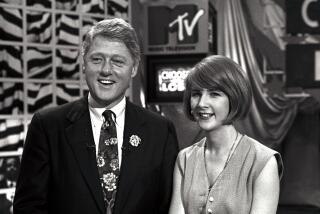The Rave of Europe : Meet the ‘Eurokids.’ They’re brash, young and so cross-continental. They love Barcelona style, Belgian tech music and satellite MTV.
- Share via
LONDON — These are the Eurokids.
They wear clothes from Chipie, Naf Naf and Kookai of France, along with other European brands. Levi’s are what their parents wear.
Barcelona is their style capital--”the new European L.A.,” it is called. Tapas are trendy. The bars and nightclubs where the Eurokids hang out are increasingly sporting the colors and designs of Spain.
Often fueled by the drug Ecstasy, they dance to rave music from Italy, Belgium and Great Britain. They are linked by international style magazines and satellite television channels--primarily MTV Europe, which beams its Euro vid-jocks and Euro-weighted playlist into 43 million homes.
The United States remains a powerful cultural force in their lives, but they’re losing interest. Japan is the faraway land that produces things new and exciting.
And while their elders, split by national identities and widely differing tastes, continue to haggle bitterly over formation of a united Europe, they already are creating their own Pan-European identity.
*
The only new thing to come out of America in the past few years has been grunge rock. What a joke.
--A 19-year-old man in Dusseldorf
*
Into the 1993 Euro-blender go the young of more than a dozen nations and out pours a homogenized youth culture dubbed “Eurokids.” The name comes from an eponymous report just published by the Pan-European advertising group Alto, which found that, increasingly, youths from Lisbon to Berlin and Stockholm to Athens have more in common with each other than with older people in their own countries.
They are bound not only by shared tastes in fashion, music and food, but also by lifestyle, attitudes and values.
Says advertising executive and report author Simon Silvester, who interviewed groups of under-25s in Amsterdam, Barcelona, Brussels, Dusseldorf, London, Milan and Paris as part of his research: “You tend to think, ‘God, these are almost the same people sitting in the room from country to country.’ ”
Even the pronounced cultural chasm that separates northern and southern Europe is dissipating. Young adults from Spain, Portugal, Greece and Italy are breaking the traditions of their parents in everything from their hunger for fast food to the breakup of the extended family.
Catching up to established patterns in northern Europe, southern European youths are moving out of their parents’ homes at an earlier age and are waiting longer to marry and have children.
“Thirty years ago, the youth agenda varied enormously from country to country,” says the Eurokids report. “Today, young people around Europe all worry about the same things.”
*
In Spain, they never sleep. They finish work at 9 o’clock at night and go out and party until 2 or 3 a.m. It’s one big party.
--A 22-year-old woman in Paris
*
Cheap foreign travel, Pan-European media and increasing numbers of youths who understand a common foreign language--particularly English--are cited as the main reasons behind the breakdown of cultural borders.
Young Europeans travel abroad far more than previous generations, says the Eurokids study. Aided by substantial youth travel discounts, they take 40% more foreign trips than the adult population as a whole. The figure increases to 60% in southern Europe.
A large proportion of Eurokids want to live and work in another European country, an aspiration that is becoming increasingly easier to realize with the emergence of the single European market. Topping the list of where they’d like to live are France, for its lifestyle, and Great Britain, for its rock music scene.
Although language remains something of a social barrier, even that wall is crumbling as more and more Eurokids learn English.
“English teaching is now so widespread and to such a level in Europe today that the vast majority of under-25s in all European Community countries now speak English,” says the report. “English has now become the lingua franca of European youth.”
MTV Europe, a major force in creating commonality among youths from the Continent’s disparate cultures, is broadcast in English--but it is specifically designed for viewers who don’t speak English as a first language. The channel’s VJs, who come from Holland, Germany, Sweden, Ireland and the United Kingdom, speak clearly. And simply.
But it’s not just the VJs and their speech patterns that mark the difference between MTV Europe and its American counterpart. The programming also is helping carve out a European identity for its viewers.
“We’ve tried to make it home grown,” says William Roedy, managing director and chief executive of MTV Europe.
In music video terms, that means adding a heavy dose of European artists to the playlist. “We are working very hard at breaking European groups,” says Roedy. Regulars on MTV Europe include Clousseau from Belgium, Ten Sharp from the Netherlands and Dr. Alban from Sweden. German rappers Die Fantastischen Vier are in high rotation on the channel.
Beyond the video clips, MTV Europe’s programming focuses on the Continent’s trends and concerns. “The channel is constantly out of the studio and around different parts of Europe,” says Roedy. MTV’s beach-party weekends happen in places such as France and Italy.
During 1993, MTV Europe plans to focus much attention on the themes of tolerance and diversity in response to the nationalist and racist violence spreading across Germany and elsewhere in Europe.
*
Americans are so poor. The ones you meet are always going on about how much everything in Europe costs. You feel so sorry for them.
--A 19-year-old man in Munich
*
MTV Europe’s role at the forefront of a Pan-European youth movement is ironic, considering that it is, after all, part of an American-owned company, Viacom Inc. But don’t tell the viewers that.
“If you talk to British kids about MTV,” says ad exec Silvester, “it’s not America they think of.”
“An increasingly un-American youth culture” is one of the main themes of the Eurokids study. “Twenty-five years ago, everything from moon landings to surf culture came from America. Europe, preoccupied with the Cold War and with a much lower standard of living, looked on enviously. In the ‘90s, all will change.”
Well, maybe it will. But for now, the United States still plays a role in defining Euro youth culture.
Despite the clear emergence of a continental pop music scene, it is still musicians from the United States and Great Britain who dominate. “In terms of rock ‘n’ roll, American music is as strong as ever, if not more,” says Adam White, international editor-in-chief of the music industry bible, Billboard. “The European charts are pretty strongly represented by American music.”
Eurobands are becoming more popular, though. “Certainly MTV Europe and radio have exposed Europeans to artists from outside their own countries,” says White. “There are some hits coming out of this process. But it’s not a break-down-the-door stampede.”
Clothing styles seem to follow a similar path. While Eurokids may be latching on to Eurobrands, the clothes still have a distinctly American flavor, no matter what the tag says. Jeans are jeans, right?
Indeed, anyone who doubts whether there still is an American influence should try counting the number of Los Angeles Raiders caps and jackets on the youths who congregate in London’s Camden Town district, a Eurokid melting pot.
And watch out for all the careening skateboarders.
This is not to say that the Eurokids haven’t created their own look, however. In particular, Europe’s all-night rave scene has produced its own music and styles.
Silvester, the advertising executive behind Eurokids, concedes there is still strong U.S. influence among the young. But the point is, he says, “there is a real alternative to American culture. It’s not omnipresent the way it used to be. The big dance and club scene in Europe is European. Everybody’s talking about Belgian tech music, which is big at the moment.”
*
What’s trendy to eat? Tapas, and above all, sushi.
--A 25-year-old man in London
*
The Eurokids study is, at its heart, about advertising and marketing, produced by advertising executives for other advertising executives. Even so, it still brings a jolt to find, near the end of the report, a big, all-caps headline that says Eurokids are “RIPE FOR EXPLOITATION.”
Makes you feel kind of sorry for them.
Nonetheless, in the real world, the arrival of the Eurokids appears to mark a big breakthrough in Euromarketing.
European advertising agencies have long been searching for ways to target continental consumers en masse. But in most cases, cultural differences have made that impossible. A simple thing like coffee represents such different things to people in Spain, Britain and Germany that separate ad campaigns are needed in each country to sell them the same product.
Not so with Eurokids, says the report: “Young people are increasingly a single target market across Europe--you can treat them as such.”
The sales pitch is changing, too.
Gone, says the report, are the days when “the standard method of doing European youth campaigns was to link the product to America. This has been done by every product (from) Coca-Cola to brands which have no real American heritage, like Stimerol chewing gum. While America remains a powerful image for Europeans, the indications are that America is no longer enough, and that advertising imagery borrowed heavily from the American Dream is now seen as a stereotype.”
If the American Dream is dying in the 30-second spots of Europe, then what is to replace it?
“Youth around Europe have gone ethical,” says the report. “They are concerned more about rain forests than clothes.”
Benetton-style ads--the dying AIDS patient, et al.--are singled out as the wave of the future for youth advertising. “The successful youth campaigns of the ‘90s will follow their lead,” the report says, “by realizing that a marginal, product-based selling point has little power compared with the lure of ethical beliefs.
“Much as we may despise their junk culture and preference for frozen pizza over fresh pasta, MC Hammer over the Rolling Stones, these people are the future of Europe. As they grow older and become the mainstream of European society, their single tastes will unify the markets they buy in.
“Eurobrats,” it concludes, “thus represent the most important generation in European marketing history.”
So: Welcome to the world, Eurokids.
What’s In
Crystals
Shamanic arts
Sharon Stone
House music
Going to Thailand
Anything Japanese
Kinky sex
Tapas
MTV Europe
What’s Out
Money
Greed
The American
Dream
Safe sex
Settling down
Yuppies
Nirvana
Sexism
More to Read
Sign up for Essential California
The most important California stories and recommendations in your inbox every morning.
You may occasionally receive promotional content from the Los Angeles Times.













